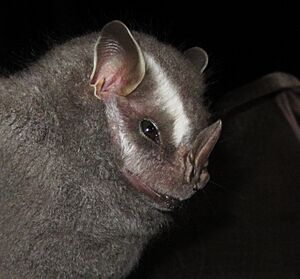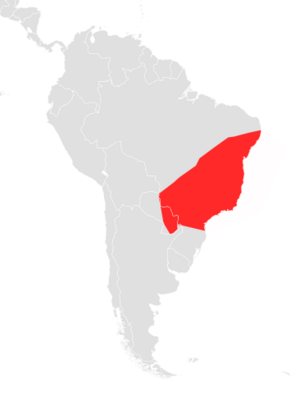Brazilian big-eyed bat facts for kids
Quick facts for kids Brazilian big-eyed bat |
|
|---|---|
 |
|
| Conservation status | |
| Scientific classification | |
| Genus: |
Chiroderma
|
| Species: |
doriae
|
 |
|
| Brazilian big-eyed bat range | |
The Brazilian big-eyed bat (Chiroderma doriae) is a cool type of bat found in South America. It's part of a group called phyllostomid bats. This bat got its scientific name to honor an Italian scientist named Giacomo Doria.
Contents
What Does the Brazilian Big-Eyed Bat Look Like?
This bat is quite small. It's about 7 to 8 centimeters (around 3 inches) long. It weighs between 27 and 33 grams, which is about the same as a few strawberries!
Like other bats in its group, it has a short nose. It also has a special feature: a large gap in its skull above the nose. This gap makes it look like it doesn't have nasal bones, but they are actually just joined to other bones.
Cool Colors and Markings
The Brazilian big-eyed bat has grayish-brown fur on most of its body. Its tummy is usually a bit darker. A really cool thing about this bat is the bright white stripe running down its back. It also has smaller white stripes above its eyes, reaching from its ears to its nose.
Its ears are round and not very long. The nose-leaf (a special skin flap on its nose) is pointy with a rounded base.
Special Teeth for Tough Food
Compared to many of its bat relatives, this bat has fewer teeth. But its teeth are very strong! It has sharp upper incisors and big molar teeth. It also has strong jaw muscles. These features help it eat hard seeds.
Where Do Brazilian Big-Eyed Bats Live?
You can find the Brazilian big-eyed bat in eastern Brazil. It lives in states like Pernambuco and Parana. It also lives further inland in Goias and Mato Grosso do Sul.
For a long time, people thought these bats only lived in Brazil. But now we know they also live in eastern Paraguay! There are no different types or subspecies of this bat.
Their Favorite Homes
These bats love tropical rainforests. But they can also live in other wooded areas. This includes small forests, farms, and even parks. If food is hard to find, they might even fly into cities like Rio de Janeiro.
What Do Brazilian Big-Eyed Bats Eat and Do?
The Brazilian big-eyed bat is a nocturnal animal. This means it is active at night. It's usually busiest after midnight.
What's on the Menu?
This bat is a herbivore, meaning it eats plants. It especially loves to eat figs! Sometimes, it might also eat other fruits or flowers.
What's special about this bat is how it eats figs. It doesn't just eat the soft fruit pulp. It also chews the hard seeds! This helps the bat get more nutrients, especially protein, from the figs. Because of this, figs can be almost their only food source.
Living Together
We don't know much about where these bats sleep during the day. They don't seem to live in big groups. Scientists have only seen groups of up to five bats together.
Bat Babies
We also don't know a lot about how these bats have babies. Some studies suggest they might breed only at certain times of the year. But others show they can have babies all year long.
Newborn bats are quite big! They can be almost two-thirds the length of their mothers. Young bats are a bit grayer than adult bats. They don't have the clear white stripes on their faces yet. But the white stripe down their back is there from the moment they are born.


